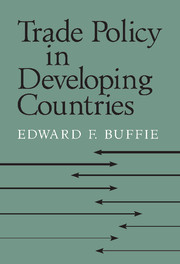Book contents
- Frontmatter
- Contents
- 1 Introduction
- 2 Tools and Tricks of the Trade, Part I: Duality Theory
- 3 The Trade Policy Debate
- 4 Tools and Tricks of the Trade, Part II: Linear Differential Equations and Dynamic Optimization
- 5 Underemployment, Underinvestment, and Optimal Trade Policy
- 6 Liberalization and the Transition Problem, Part I: Transitory Unemployment
- 7 Tools and Tricks of the Trade, Part III: The Dynamics of Temporary Shocks
- 8 Liberalization and the Transition Problem, Part II: Credibility and the Balance of Payments
- 9 Direct Foreign Investment, Economic Development, and Welfare
- 10 Suggestions for Future Research
- References
- Index
9 - Direct Foreign Investment, Economic Development, and Welfare
Published online by Cambridge University Press: 29 July 2009
- Frontmatter
- Contents
- 1 Introduction
- 2 Tools and Tricks of the Trade, Part I: Duality Theory
- 3 The Trade Policy Debate
- 4 Tools and Tricks of the Trade, Part II: Linear Differential Equations and Dynamic Optimization
- 5 Underemployment, Underinvestment, and Optimal Trade Policy
- 6 Liberalization and the Transition Problem, Part I: Transitory Unemployment
- 7 Tools and Tricks of the Trade, Part III: The Dynamics of Temporary Shocks
- 8 Liberalization and the Transition Problem, Part II: Credibility and the Balance of Payments
- 9 Direct Foreign Investment, Economic Development, and Welfare
- 10 Suggestions for Future Research
- References
- Index
Summary
In previous chapters I analyzed in detail the arguments for and against protection, the relationship between major factor market distortions and optimal trade policy, and the problems that arise in managing the transition to a more liberal trade regime. These issues are central to the conduct of commercial policy. They are not, however, the only issues that preoccupy minstries of trade in developing countries. The treatment of direct foreign investment is also an important aspect of trade policy. Foreign firms dominate the production of resource-intensive exports and account for a large share of investment and employment in manufacturing in Sub-Saharan Africa, in numerous island economies, and in parts of Latin America and Asia. Nor is this likely to change anytime soon. The recent financial crisis in East Asia will no doubt make policy makers more cautious about accepting hot money and intensify the competition to attract direct foreign investment. If anything, foreign firms will be more important players in the near future.
Although most LDCs desire foreign investment (FI hereafter), they are also wary of its side effects. Policy makers want FI only on terms conducive to economic development. This leads, inevitably, to a certain amount of tension. If FI is valued as a source of employment, technology transfer, tax revenues, and marketing outlets, it is also feared as a powerful competitor that may discourage domestic investment. The fear that FI will strongly crowd out domestic investment is a legitimate economic concern, not just raw xenophobia.
- Type
- Chapter
- Information
- Trade Policy in Developing Countries , pp. 293 - 369Publisher: Cambridge University PressPrint publication year: 2001



